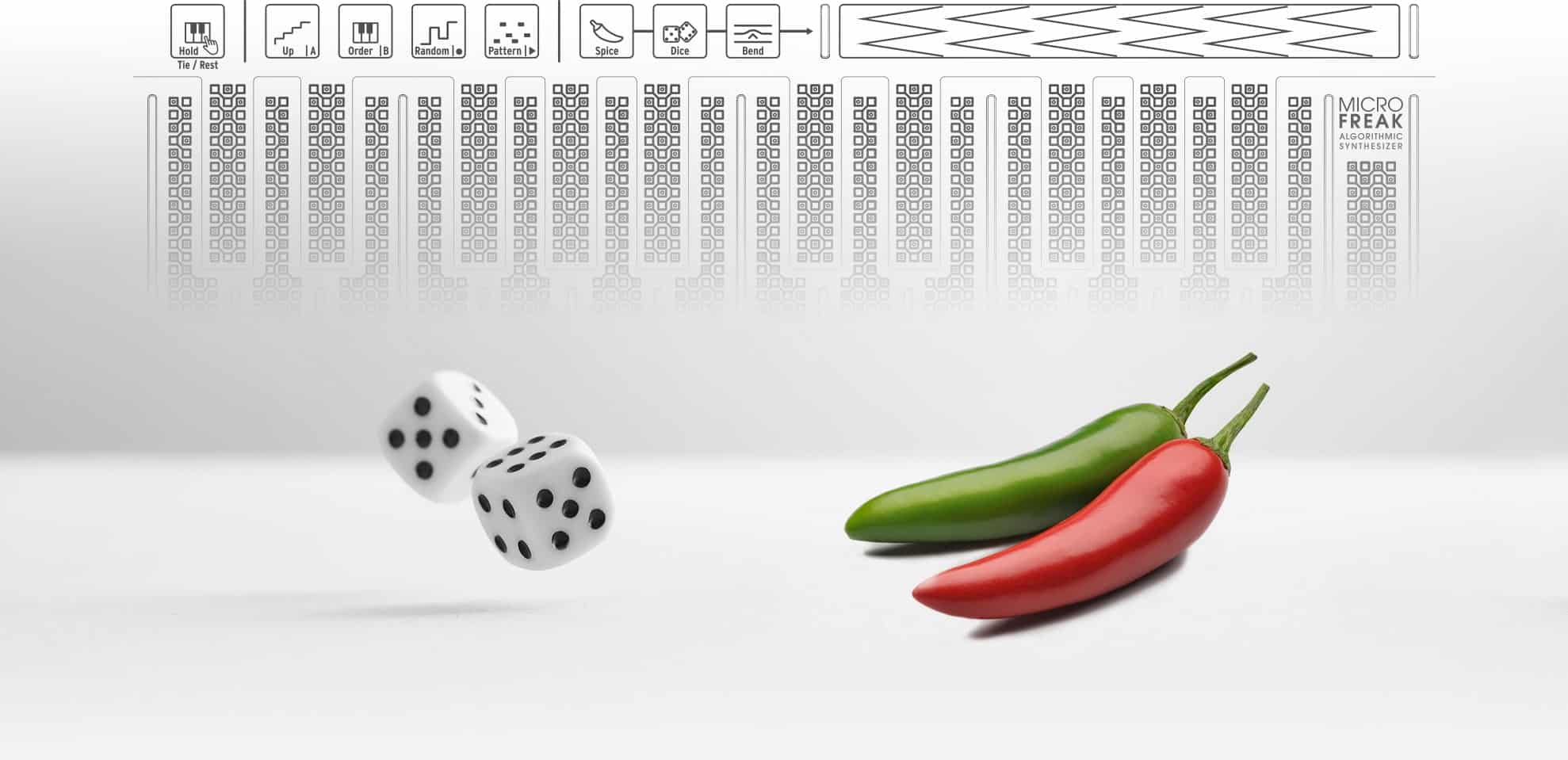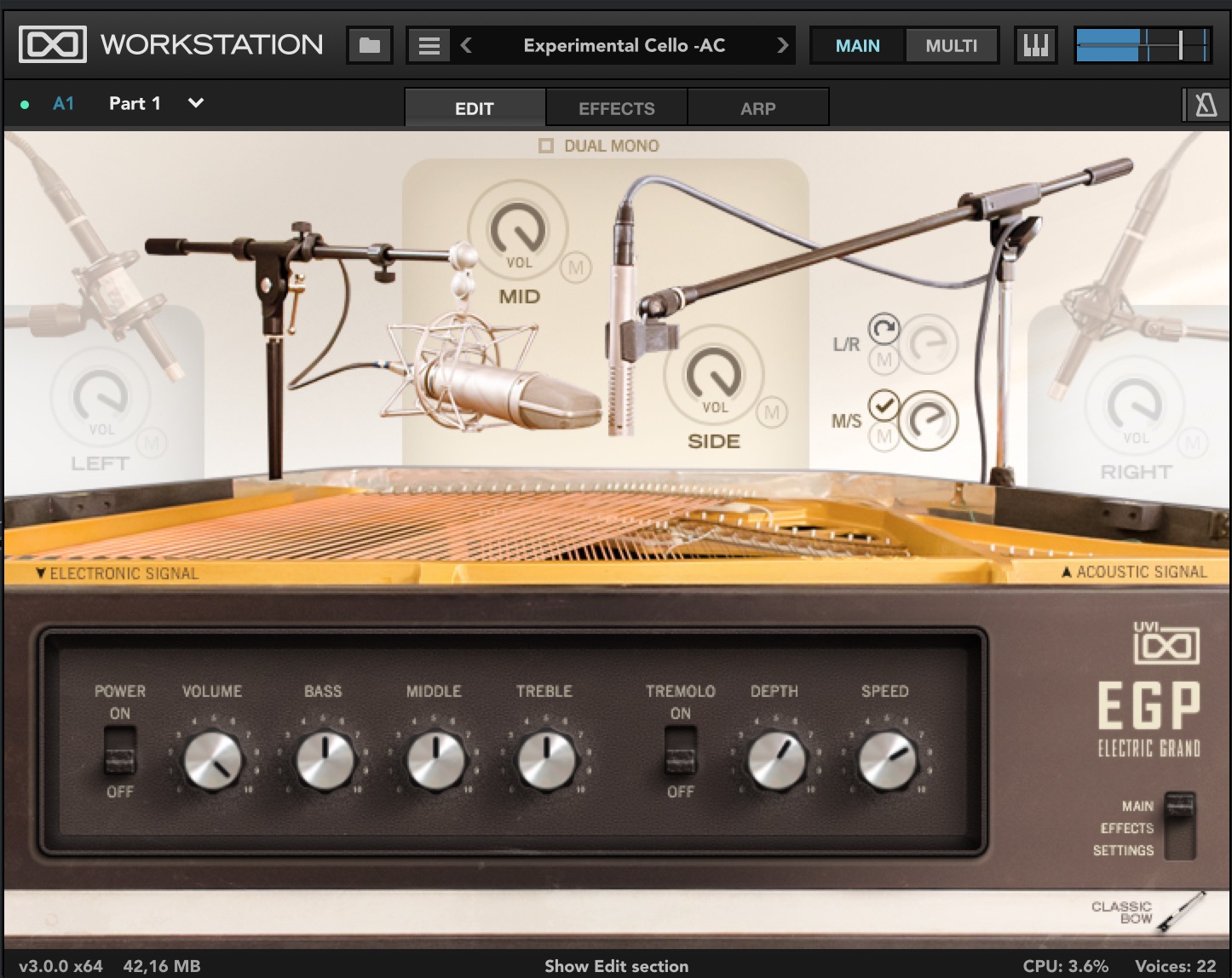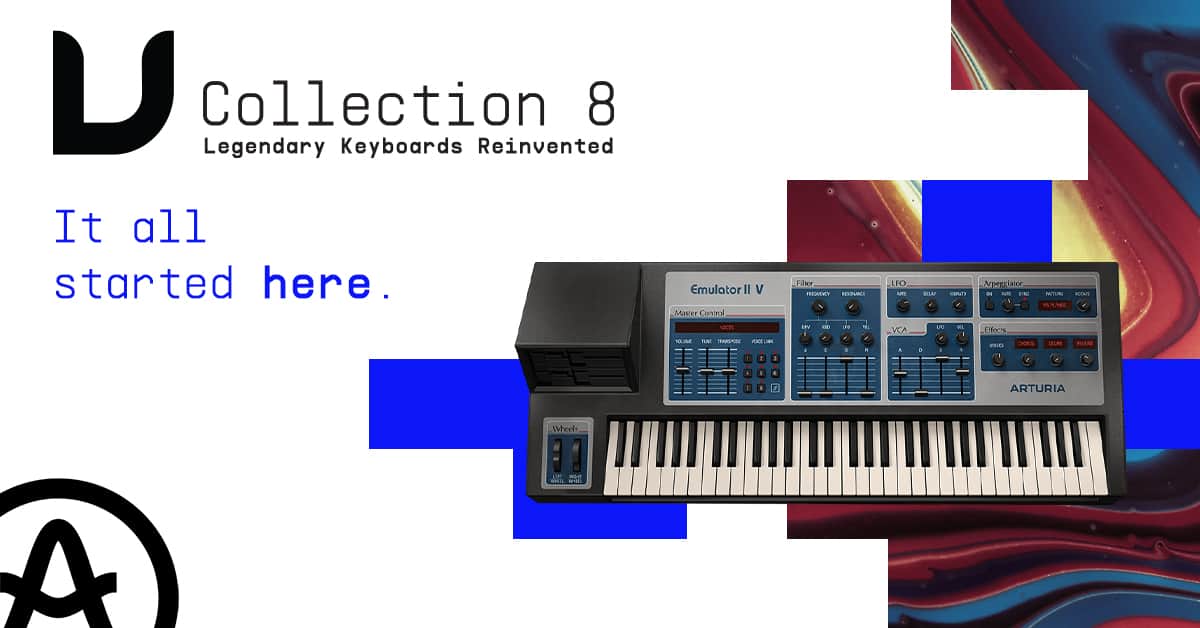MicroFreak by Arturia Review
In today’s review, we are looking at an experimental hybrid synth by Arturia. The MicroFreak is available at the astoundingly 300 Euro price range.
So, is it worth the investment?
Let’s find out in our Microfreak review.
The MicroFreak comes in a small and convenient form factor with a keyboard that’s just 25 keys. It has an array of CV/Gate inputs and outputs for controlling other hardware, as well as a USB port that can be used to connect to a computer for MIDI control.
The synth engine consists of a digital oscillator, an analog filter, a VCA, and a modulation matrix.
How flexible is the MicroFreak?
One of the first things you’ll notice about MicroFreak is how flexible it is.
The oscillator can produce both digital and analog waveforms, the filter can be switched between lowpass and highpass modes, and the VCA can be bypassed or put in voltage-controlled mode, or it can be switched between log and linear response curves.
The MicroFreak has a lot of great features and overall is very well-built.
But what is it like to use?
The MicroFreak is a paraphonic four-voice, compact, smart, and packed synthesizer with advanced digital oscillators plus an SEM analog filter. Arturia did send a review unit with no strings attached.
Microfreak Review
You may think that MicorFreak based on its form factor is an anywhere, any time synth, I can tell you it is much more than a small anywhere synth or a Mutable Instruments Plaits in a box with a keyboard attached. Still, one significant benefit is that you get the much-loved Plaits Mutable Instruments unit converted into this synth.
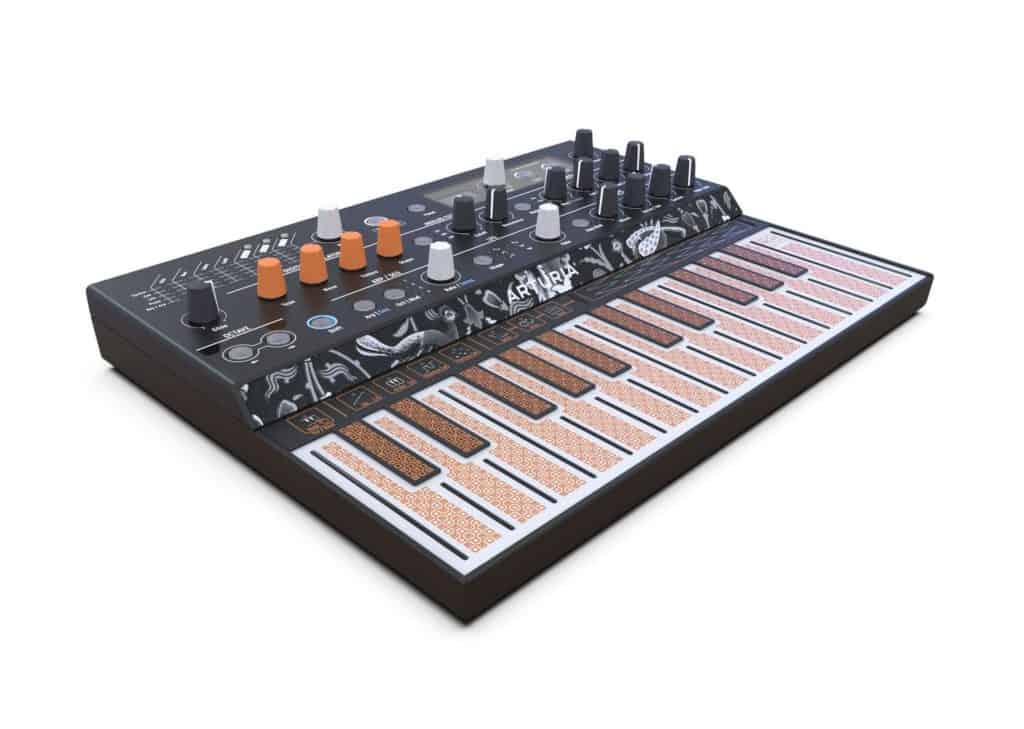 MicroFreak
MicroFreak
Installation
The MicroFreak comes with an external power adapter. However it can be used with a power bank, but for it to be fully functional the MicroFreak must be properly grounded.
Sound
Arturia enters the market with another compelling low-cost analog with the Arturia MicroBrute and drums machine DrumBrute Impact. The MicroFreak is a hybrid Synthesizer with digital oscillators, LFO, an analog filter, and more. The Oscillator offers 12 different types with seven Oscillator types coming from Mutable Instruments Plaits.
The 12dB Multi-Mode VCF is formed after the Oberheim SEM and responds very boldly to the many colors of the included oscillators. MicroFreak is usually bright sounding and the analog filter changes that for good.
I can say that MicroFreak is one of the most innovative synthesizers. The digital Oscillators Modes, produce very own sounds. It is an ideal supplement to analog synthesizer and Eurorack.
Not many may know this. MicroFreak possesses 11 different oscillator modes, including seven that were created in by Mutable Instruments. If you are into modular or semi-modular, you recognized the excellent modular models developed by Mutable Instruments and definitive the Plaits unit.
Plaits open source is the base for seven Plaits engines taken into the MicroFreak. This is not unique to Arturia. You can discover Mutable Instruments’ DSP code in the Korg Prologue, the Axoloti, the Organelle, VCV Rack, and more software and hardware. Plenty of other bits of software or hardware.
Plaits’ open-source code is capturing everything Mutable Instruments has discovered. It enables making vibrant and harmonious sound sources managed by a few parameters. If you wonder Plaits gives you 16 modes and Mutable Instruments regularly updates them.
MicroFreak as of May 2019 includes 12 oscillator types. More can be added with a new firmware release by Arturia. New releases of the firmware can be found here.
Digital Synth / Digital Oscillator

Mutable Instruments Plaits Oscillators
Mutable Instruments Plaits Oscillator Modes
- Virtual Analog – A recreating traditional synth methods digitally for a mix of classic and cutting-edge tones.
- Waveshaper – A triangular wave, processed by waveshaping and wavefolding creating squelchy, aggressive, and often metallic tones.
- 2-operator FM oscillator – A simple but powerful twin-operator FM oscillator, with two sine waves, modulated each other’s phase to create sharp, acidic tones.
- Formant – A percussive, granular synthesis engine that is great for adding huge texture and body to sequenced rhythms.
- Chords – A paraphonic synth engine that triggers duplicates at set intervals, creating defined, static chords with one key, perfect for trance-inspired melodies.
- Speech – A paraphonic synth engine that triggers duplicates at set intervals, creating defined, static chords with one key, perfect for trance-inspired melodies.
- Modal – A paraphonic synth engine that triggers duplicates at set intervals, creating defined, static chords with one key, perfect for trance-inspired melodies.
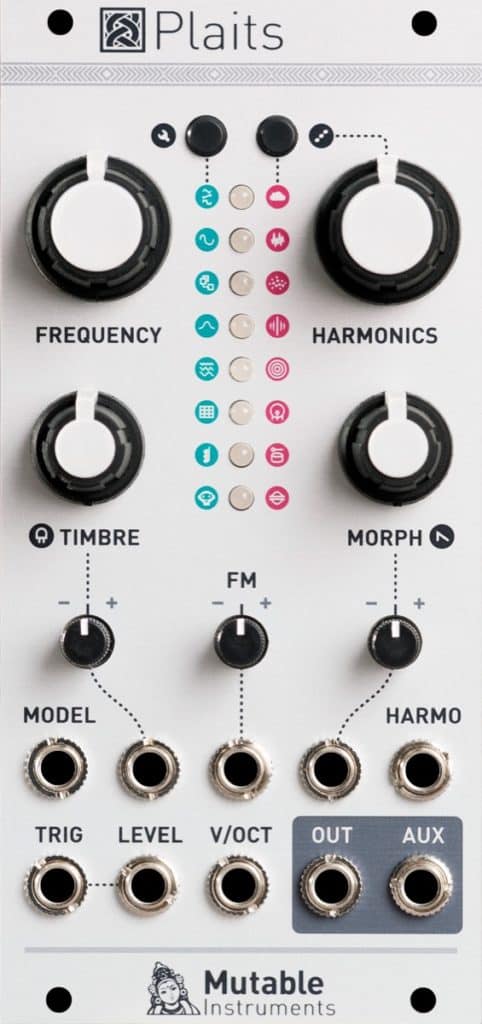
Arturia digital oscillators
- Superwave – Precisely detuned saw, square, sine or triangle waves let you create the fattest synth sounds around. Perfect for Trance and lush dreamy pads.
- Harmo – Synthesize your sound from 32 sine waves by modulating their volume. The clue is in the name, it creates harmonically rich, vibrant sounds which can be shaped with the filter.
- Karplus Strong – Synthesize your sound from 32 sine waves by modulating their volume. The clue is in the name, it creates harmonically rich, vibrant sounds which can be shaped with the filter.
- Wavetable – Synthesize your sound from 32 sine waves by modulating their volume. The clue is in the name, it creates harmonically rich, vibrant sounds which can be shaped with the filter.
- BasicWaves – This oscillator emulates two basic waveforms: the square and the sawtooth. A square wave contains only odd harmonics, and a sawtooth only even harmonics, both having their own unique character.
Analog SEM Filter
All digital oscillators can be routed through an analog filter (Oberheim SEM). Combining the different digital oscillators with the analog SEM type of filter is an excellent combination. You can mangle and shape the almost clean, uncolored sounds of the oscillators with the analog, lush, fat and tasty 12-dB per-octave filter, all based on the legendary Oberheim-designed SEM filter. You can apply a Low-pass, a Band-pass and a High-pass filter. I did have a lot of fun with the Low-Pass screen which changes or sacrifices of the highs. Warms up the lows with some dynamic character. The Analog Filter allows you to highlight or contain the harmonics produced by the Digital Oscillator. More effects like delay or reverb need to be provided by additional gear like effects pedals, alternative you can summon the recorded track into your DAW and add software-based effects.
MicroFreak comes with excellent Oscillators based on Plaits Mutable Instruments, and Arturia own developed ones. The three aspect analog filter and the Oscillators help you to create spectral sounds. Almost like a Eurorack module, I have just compared to luxury modular space at a much lower price point. IF you are a fan of Mutable Instruments Plaits the entire reason to go for a MicroFreak is to have Plaits in a small transportable keyboard form factor. The MicroFreak is a fitting mate to your Eurorack.
Presets
The 160 factory presets are not really telling you what this synth can do, I was not impressed with the overall sound of the presets. After diving into the synth I got a much better impressive and positive view on this hardware.
Summary
Arturia’s MicroFreak comes with a convincing digital oscillator (Mutable Instrument and Arturia) and an analog filter and a modulation matrix. The incorporated SEM based filter changes the timbre of the oscillator in a remarkably musical and charming way.
User interface & Usability
The keyboard has a clear precise layout. There is s small and tiny OLED to update you on your latest changes. It is small and there is not more space in this small form factor for a bigger one. For the beginner users of the MicroFreak, you can get lost if this is your first synth. After some time you are mastering the knobs and parameters you are all set. A word of warning if you turn the encoder to load another preset, you’ll lose the changes you just made.
Spice, Dice, and Mod Matrix
When you first start to use the synth you may wonder what to do with three key features: (a) mod matrix, (b) spice and (C) dice features which allow you to add some randomness and musical changes to your track. You have to experience it yourself how much fun and how encouraging performing with slice and dice is. These features transform your played tracks in the arpeggiator and sequencer into a rhythmic and tonal experiment.
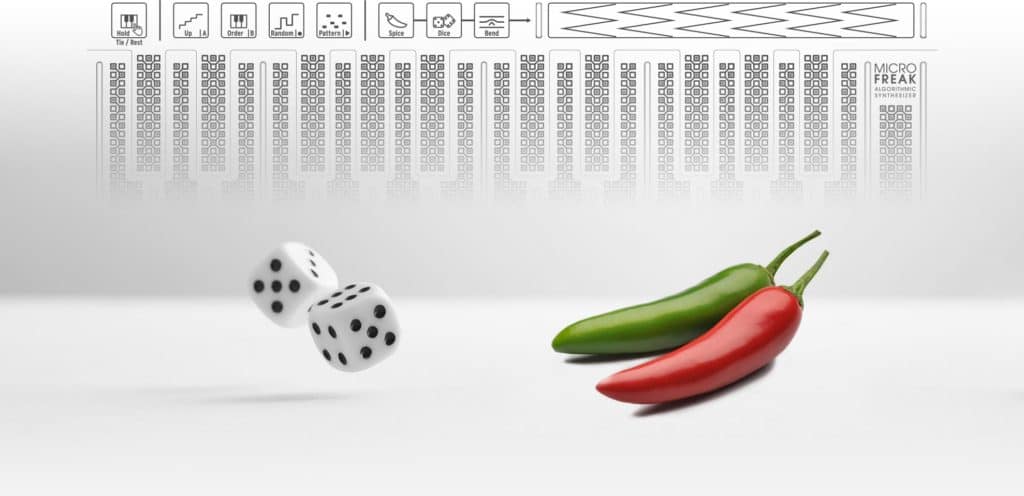 microfreak spice dice
microfreak spice dice
MicroFreak matrix patchboard reminded me a lot of the Matrix included in the MatrixBrute. It is a limited feature matrix compared to the MatrixBrute and allows you to route modulation to the control of different parameter of the sound produced.
LFO
The included LFO is a low-frequency oscillator that can produce various waveforms at sub-audio frequencies (0.05Hz up to 100Hz). The MicroFreak provides one LFO with six waveforms:
- Sine rises and falls between its minimum and maximum values
- Triangle rises and falls in more of a linear way between its minimum and maximum values
- Sawtooth rises linearly to its maximum value and then drops suddenly to its minimum value
- Square rises and falls suddenly between its minimum and maximum values
- Random stepped rises and falls suddenly between values that are generated at random
- Random gliding rises and falls gradually between values that are generated at random
 MicroFreak and MatrixBrute – both by Arturia
MicroFreak and MatrixBrute – both by Arturia
The Modulation Matrix routes MicroFreak modulation origins to modulation targets with an attenuator that enables for positive or negative modulation. Every parameter that it would make sense to modulate can be a destination. Arturia hardwires destinations 1 to 4, and destinations 5, 6, and 7 are freely assignable by you. The MicroFreak with its very different algorithms is extremely flexible when producing sound with oscillators. The tone and vibe are additionally improved by the modulation matrix.
Keyboard
The keyboard is very snappy and fast. Don Buchla would be proud of Arturia’s keyboard. The 25-key printed circuit board is fast as mentioned and supports pressure or aftertouch on each note individually. The footprint of your skin hitting the keyboard is changing the resulting tone and sound you hear. If you want you can, of course, attach a regular keyboard or sequencer to the MicroFreak. There are Arpeggiator and Sequencer controls, and a touch strip with a Bend icon and two Spice and Dice icons that enable you to create variations on the Sequencer and Arpeggiator patterns. The keyboard of the MicroFreak is touch capacitive and has 25 keys. When performed the keys generate gate, a pitch, and pressure. It covers a two-octave range, which can be extended using the Octave Down/Up buttons. You can use aftertouch or velocity control, not at the same time.
Connectivity to the World of Hardware
The device offers CV outputs, letting you send pitch, gate, and pressure signals to any outboard or modular synth that’s CV/Gate compatible. With the whole semi-modular movement I wish there is an MK2 version with more semi-modular connections, that to me would be a killer even at a slightly increased price. This machine wants to talk and be part of a eurorack setup. The included CV and Gate out transmit electrical signals to an external hardware synth or a Eurorack modular system. You can drive the MicroFreak and sync it to external synthesizers or modular systems by using the Clock input/output.
 MicroFreak back view
MicroFreak back view
Freaky Ideas
You one of the individuals who like to experiment, who wants to process something completely different from the usual standard sounds. the MicroFreak is an ideal complement to the sound palette without the need to go modular. Take a look at the manual otherwise you miss what Arturia labels “Freaky Ideas” – a collection of modulation ideas:
Change pitch scope
Without making any connections on the Matrix the keyboard or a sequence will already modulate the pitch of the oscillator with 1v per octave. If you take a sequence and add that already existing modulation on the Matrix (route Key/Arp to Pitch), you can drastically change the pitch scope of the sequence. Steps that were one semitone in the original sequence will now be 2 or even four semitones. When you apply negative modulation, the step distance will shrink to microtonal proportions.
Summing modulation signals
Both envelopes: the Standard Envelope and the Cycling Envelope are sources for modulation in the Matrix. You take advantage of that by mixing their output to control the same destination. Why would you do that? By mixing the control voltages, you create a complex envelope that can control the filter or arpeggio rate in unexpected ways.
Take a look at the Manual to learn more about
- Modulating the Digital Oscillator
- Regular automatic transpositions
- Modulating Modulation
- Circular routings
Is the Arturia MicroFreak worth it? (Conclusion)
The MicroFreak is an experimental hybrid hardware synthesizer made by Arturia. The keyboard is touch capacitive and has 25 keys, which when performed the keys generate gate, a pitch, and pressure. It covers a two-octave range, which can be extended using the Octave Down/Up buttons.
Connectivity to the World of Hardware comes in the form of CV outputs that allow you to send a pitch, gate, and pressure signals to any outboard or modular synth that’s CV/Gate compatible.
Finally, with the whole semi-modular movement I wish there is an MK2 version with more semi-modular connections, that to me would be a killer even at a slightly increased price.
Manufacturer Arturia Model MicroFreak Synthesizer Type Semi-Modular Keyboard Touch capacitive Key 25 Keys Pitch Routing Analog I/O CV Output, Gate Output, Velocity Sensing Filter Band-Pass with Low-Hi Shelf Potentiometer ADSR Envelope Generator Cycling / Standard Modulation Matrix Voltage.
That there is no traditional keyboard was not an issue for me when playing and performing with it for some minutes. The keyboard is touch capacitive and has 25 keys, which when performed the keys generate gate, a pitch, and pressure. It covers a two-octave range, which can be extended using the Octave Down/Up buttons.
Rating: Five out of five stars
Arturia’s MicroFreak is a complete production synthesizer is a hybrid hardware synth with Mutable Instruments Plaits oscillators, plus an outstanding analog filter, a unique keyboard, and a modulation matrix to create a palette of unique sounds, unusual textures, and evolving sequences. The analog filter produces the warmth and punches harmonics for the sound you want in your tracks.
MicroFreak is unusual, freakish, distinctive, unique, strange, extraordinary – the synth is a result of a brilliant collaboration of Arturia with Mutable Instrument. MicroFreak is an amazing little synth monster that can produce magic, weightiness, elegance, strength, and endless variation.
If you are into Eurorack the included Oscillators are based on Mutable Instruments Plaits which makes a MicroFreak a small transportable Plaits with a keyboard form factor. MicroFreak works also well in combination with Eurorack. This synth is a freak in the most unexpected positive way.

